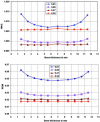Effects of skull thickness, anisotropy, and inhomogeneity on forward EEG/ERP computations using a spherical three-dimensional resistor mesh model
- PMID: 14755596
- PMCID: PMC6872130
- DOI: 10.1002/hbm.10152
Effects of skull thickness, anisotropy, and inhomogeneity on forward EEG/ERP computations using a spherical three-dimensional resistor mesh model
Abstract
Bone thickness, anisotropy, and inhomogeneity have been reported to induce important variations in electroencephalogram (EEG) scalp potentials. To study this effect, we used an original three-dimensional (3-D) resistor mesh model described in spherical coordinates, consisting of 67,464 elements and 22,105 nodes arranged in 36 different concentric layers. After validation of the model by comparison with the analytic solution, potential variations induced by geometric and electrical skull modifications were investigated at the surface in the dipole plane and along the dipole axis, for several eccentricities and bone thicknesses. The resistor mesh permits one to obtain various configurations, as local modifications are introduced very easily. This has allowed several head models to be designed to study the effects of skull properties (thickness, anisotropy, and heterogeneity) on scalp surface potentials. Results show a decrease of potentials in bone, depending on bone thickness, and a very small decrease through the scalp layer. Nevertheless, similar scalp potentials can be obtained using either a thick scalp layer and a thin skull layer, and vice versa. It is thus important to take into account skull and scalp thicknesses, because the drop of potential in bone depends on both. The use of three different layers for skull instead of one leads to small differences in potential values and patterns. In contrast, the introduction of a hole in the skull highly increases the maximum potential value (by a factor of 11.5 in our case), because of the absence of potential drop in the corresponding volume. The inverse solution without any a priori knowledge indicates that the model with the hole gives the largest errors in both position and dipolar moment. Our results indicate that the resistor mesh model can be used as a robust and user-friendly simulation tool in EEG or event-related potentials. It makes it possible to build up real head models directly from anatomic magnetic resonance imaging without tessellation, and is able to take into account head heterogeneities very simply by changing volume elements conductivity. Hum. Brain Mapping 21:84-95, 2004.
Copyright 2003 Wiley-Liss, Inc.
Figures













References
-
- Akhtari M, Bryant HC, Mamelak AN, Flynn ER, Heller L, Shih JJ, Mandelkern M, Matlachov A, Ranken DM, Best ED, DiMauro MA, Lee RR, Sutherling WW (2002): Conductivities of three‐layer live human skull. Brain Topogr 14: 151–167. - PubMed
-
- Ary JP, Klein SA, Fender DH (1981): Location of sources of evoked scalp potentials: corrections for skull and scalp thicknesses. IEEE Trans Biomed Eng 28: 447–452. - PubMed
-
- Awada KA, Jackson DR, Williams JT, Wilton DR, Baumann SB, Papanicolaou AC (1997): Computational aspects of finite element modeling in EEG source localization. IEEE Trans Biomed Eng 44: 736–752. - PubMed
-
- Benar CG, Gotman J (2002): Modeling of post‐surgical brain and skull defects in the EEG inverse problem with the boundary element method. Clin Neurophysiol 113: 48–56. - PubMed
-
- Bertrand O, Thevenet M, Perrin F, Pernier J (1992): Effects of skull holes on the scalp potential distribution evaluated with a finite element method. Proceedings of the 14th International Conference of the IEEE Engineering in Medicine and Biology Society, Lyon. p 42–45.
MeSH terms
LinkOut - more resources
Full Text Sources

